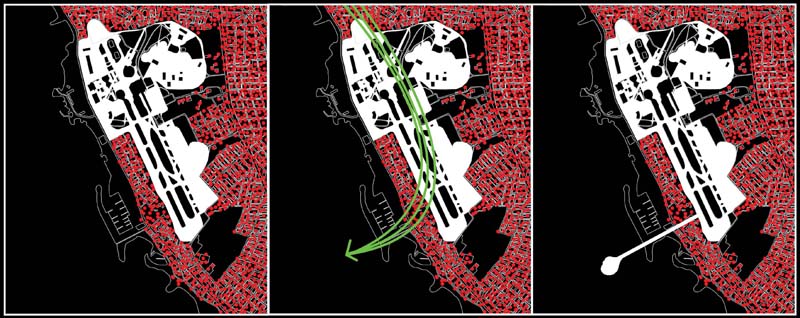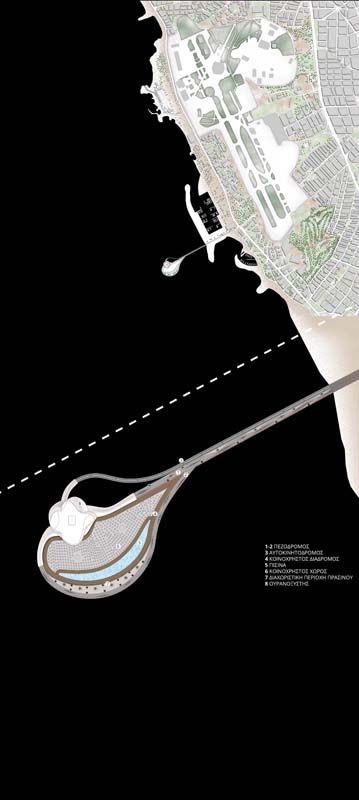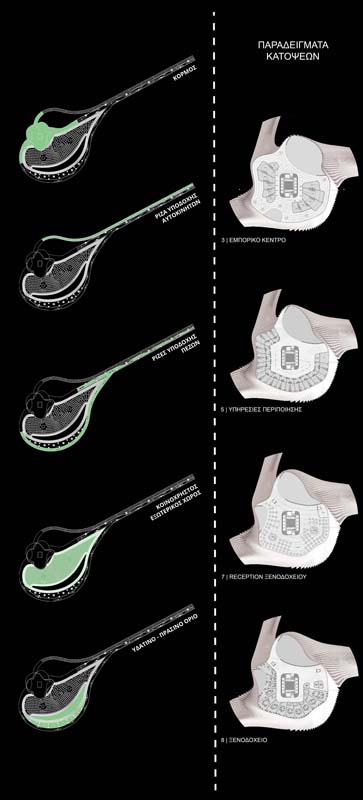











Greece is one of the most renowned summer destinations worldwide. The most famous Greek tourist product so far is the sun and the sea that characterize the climate of this place Taking into account this information in conjunction with the timeliness of the country, the aim of this thesis is the design of a new tourism product which aims to bring out the natural beauty of the country and the culture of the Greek people.
Analyzing the tourism data of the country, it can be concluded that the new tourist product should attract as much as possible more visitors from distant countries such as India, China, Brazil, etc. To achieve this goal I chose to create something that will introduce a new "language" in the tourism infrastructure of Greece, in order to stimulate interest of foreign tourists. This is the first tourist skyscraper in Athens.
This new building’s form and character derive from the olive tree donated by goddess Athena to the Greeks, which was useful for light, heat, diet, etc., from the columns that characterize the ancient Greek monuments like the Parthenon and the rugged natural landscape of Mount Hymettus. As a result, the new skyscraper is characterized by intense sculptural form that emerges as a body through the sea of the Saronic Gulf and derives its name from Triton god, described in mythology as the god of the sea and was presented in similar manner by the ancient Greeks.
Supervisor: Papadopoulos Spiros
Reference Number: 614


The aim of this diploma project is to create an SOS children’s village in Alikes of Volos. SOS children’s villages house children who have been removed from their birth families, in 152 countries. The organization was founded in Austria, in 1949, by Herman Gmeiner and, counter to traditional child care institutions, provides a caring family environment to children in need. There are three SOS villages in Greece, placed in Athens, Thessaloniki and Alexandroupoli, housing 160 children. The new village is located in a 3.300 m2 area, 160 meters far from the beach. The project includes twelve houses, where children and the mothers who take care of them live, as well as public facilities such as art studios, that can be used both by the children who live in the village and the district residents, helping the village become a part of the community. The design goal is to satisfy the children’s special needs and contribute to their mental growth and personality development.
Supervisor: Manolidis Kostas
Reference Number: 652


Lake’s Karla visitor identity belongs to a wide range of people who wish to experience it, such as: special scholars and landscape analysts, school departments with the aim of enhancing the environmental awareness of the pupils through interaction with nature, individual fishermen or groups wishing to fish, groups of farmers wishing to hold a conference, or amateur visitors for whom this landscape is a point of reference. Coming to the starting point and having left the vehicle, the visitor meets a reception and an information area. The wandering in the lake area continues through a path leading to a wooden deck which enters the lake. Here the spectators can watch the sunset, and observe, while they can also have a tour with boats and canoes. Crossing this central corridor creates a spatial network in the form of waves. This installation provides accommodation for 3-4 persons, it also has double rooms and single rooms. Shortly before the end of the main corridor and on either side of it there are the environmental information areas, an exhibition area and a restaurant overlooking the lake. The proposal is based on the philosophy of functional autonomy of the basic programming uses with absolute clarity but the simultaneous perception and respect of the urban and morphological topography of the piece. The piece is located in a low-built area, and the synthetic proposal opts for the construction of ground-level pieces placed pointwise in a form that follows the waves of the lake. Through the palm of the materials, colors and textures of the landscape of Lake Carla, an earthy and intensely experiential building is created, where the visitor can read directly through the materials and textures of the construction. The oxidized earth is taken up by lining of exterior walls with CORTEN steel alloy panels. The use of wooden exterior floor on the outside floors of the entrance and the outside of the refreshment point to the colors and textures of the flora of the area. The vegetation, to a large extent and to the roofs (planted), reminds the visitor of the natural landscape in which the building is included. The ultimate goal is to "get life again", Lake Carla, by informing and sensitizing society by providing an organized space of hospitality.
Supervisor: Triantafillidis Giorgos
Reference Number: 632


The present thesis project discusses the matter of definition of the public space, in a conceptual and morphological content, from the users of that space themselves, through the organisation and application of a method of participatory design. Chalandri square is selected as case of public space. We focus on the phenomenon of open musical improvisations (Jam) that happen there, with the initiative of the local habitants. We pursue to involve with them in an exchange of ideas and thoughts of the space, of how we would like the square to be as the place where the jams occur. Our meetings with them happen in real time, evolve in the public space and are accompanied by objects that function as “tools” to support our method. With these objects is triggered and recorded the production of the ideas above. Our method unrolls in an experimental manner, step by step, is being redefined each time by the participation of others in it and is divided in three basic levels. The first level concerns the installation of the objects in the space of the square, by ourselves, during two jammings, with the purpose of the introduction of an architectural process that concurs with the musical improvisations and in which participate the people that are located in the space at that time. Through these open processes which evolve at the same time, the public character of the square is enhanced and an investigation of the desires linked with its space occurs. The second level takes place in the square and in a park close to it, where we set up the field for conversations about the square, the jammings in it and the desires mentioned above, to happen. This procedure is in the form of a workshop and is realised with the participation of people that had attended the square’s jammings. The third level is the in-situ application of the above suggestions as the preparation of the square for another jam. During this last jam, the interventions were used by the people that took place in their conception and design process as well as from the rest of attendants.
Supervisors: Lykourioti Iris, Remy Nicolas
Reference Number: 646


Our thesis project is about more of a design practice than a building structure. Alternating parameters of urban habitation we create new living models, aiming at a strategy that someone can follow at any level, regarding his needs.
Our staring point is the circulation system, a central core for the structure designed as a continuity of the street, therefore an open public space. It is about two stairs with different orientation leading to different parallel alleyways forming a dna shaped staircase. Its two stairways are independent. There is visual contact but access is impossible.The apartments are attached to the staircase in pairs. Each apartment is typically partitioned in two, given the advantage of autonomy of a person or a procedure. The housing units range from 25m2 to 100m2 on a grid plan of 5m providing at least one private balcony and access to public spaces.
The project is in fact a catalogue of versions. This strategy of vertical development, with staircaseunits creating a residential building, is applied under 4 possible versions of bountaries. Therefore, 4 structures are produced and subsequently, 4 blocks as a combination of these structures. Staircaseunits, always used in the perimeter of free space, create an open circulation system, that in both axes links public, semi-public and private space. Public terraces are accessible from the street and their size is adjusted in any occasion with the retraction of perforated metal panels.
Supervisor: Paniyiris Costis
Reference Number: 630


Kyparissia is a small provincial town in the northeast area of the prefecture country of Messinia. It develops amphitheatrically from the foot of the mountain “Phychro” to the sea. This seafront (approximately 1.7km) is characterized by a variety of morphology - sandy beaches, crags, small creeks and a marina. Instead of what someone is going to expect, this seafront isn’t a part of the citizens’ everyday life, with the exception of summertime period. It appears an image of desolation and abandonment. The lack of some special design and maintenance of the public space, the unformed space of the marina and the municipal land of the southwest extension of the city, the general operational problems of the marina, the absence of infrastructure that could accommodate human activities, are some of the basic issues identified in the research of the area. A city in contract with the sea and simultaneously away from it.
The recovery effort of this contact is made with terms of urban design. How can the urban fabric be associated with the sea? How is the intermediary border between them formed? Questions of the synthetic search which tries to identify ways of contact between the existing urban infrastructure and the sea (beaches, creeks, marina). Something that once can been made in gentle way, where the natural landscape dominates, and in other occasion more “urban”, where the background has been spoiled by human e.g. the marina. The method of connection with the city through circulation networks (motorways, pedestrian zones, bicycle paths) is being examined too, as it does attempt to limit car circulation. Deeper target of all the interventions is the recovery of the contact with the sea.
Supervisor: Trova Vasso
Reference Number: 622


The thesis focuses on the temporary housing of the homeless people of Thessaloniki and their parallel education and support in order to reintegrate as active and independent citizens in the society. All structures for homeless people are staffed by non-governmental organizations and the buildings that currently house these structures are no more than apartments with limited functionality and facilities, which are temporarily rented for these purposes. This observation was the main reason for choosing this subject. The research focuses on the study and the design of a center that gathers the necessary structures and houses them in a single space to function more efficiently and not have a temporary character. The site was chosen based on a number of reasons. An empty plot of land was needed in the western part of the city with sufficient space for the development of the program and one that offers easy access to the city and transportation, without disturbing the cohesion of the local community. Based on the above, the selected site is located on the corner of Giannitson and Dafnis street in western Thessaloniki, in a region with evident commercial and industrial presence and fewer residences. The building program for the center includes structures for housing the homeless as well as facilities to support and educate them to achieve autonomy and reintegration into the society. The separation of different functions is done in three separate buildings. The first one features a day center, resting areas, a dining room and the main dormitory. The second building has rooms for hosting families with children or other more independent people with high training and skills. Finally, the third building has training areas, classrooms, a library, an infirmary as well as counseling and support services.
Supervisor: Manolidis Kostas
Reference Number: 640


Isthmus of Corinth is a landmark in Greek area since the ancient era. It’s drilling occupied engineers since the classical period to the late 19th century. All the attempts for its drilling during the ancient times failed due to the lack of know-how. Finally, during the 19th century the marine connection of the two gulfs is managed through an astonishing for the time process, in which worldwide fame engineers contributed. The connection of Corinthian and Saronic Gulf through the ancient Diolkos changed the maritime facts replacing the sailing of the whole Peloponnese. As a result, the drilling of Isthmus constitutes a landmark for the area, detour for the commercial ships and a touristic attraction for the passengers.
Nowadays the land connection of Main Greece and Peloponnese is managed through two national roads, railways and pedestrian bridge that unify the gap created by Isthmus. Moreover, at both ends of Isthmus the connection is managed through emerging bridges for vehicles and pedestrians.
Due to the constant transit of vehicles, the area contains many buildings that serve the stopped drivers. In addition a long-distance bus stop exists besides the old national road in which busses stop constantly. These stops have also a touristic function as they sell souvenirs of Isthmus and ancient Diolkos. The cultural value of the area and the landmark of Isthmus gave a boost for touristic developments. Though, the distance from the city centers did not help any attempt. Thus, many hotel and commercial plans were abandoned and even constructions were left half-finished.
In addition, the fast passage through the national roads and the railways does not allow the view of Isthmus for more than a few seconds from the inside of the vehicle. The pedestrian bridge is distanced far enough from the stops and thus the only opportunity for viewing Isthmus is given from atop the old national road, underneath of which extreme sports activities take place. The longitudinal walk of Isthmus along the slopes is partially managed through dirt roads.
Moreover the extant parts of the ancient Diolkos are left unprotected and shelterless, without any highlighting for the visitors, while the museum that was created for the specific monument is in distance and downgrades it even more.
Thus, the need for touristic highlight, the demands for protecting the cultural stuff that concerns the monuments of Isthmus and Diolkos, the need for sheltering the stopped bus passengers and the vehicle passengers and the lack of cultural centers at the vicinity of Posidonia and Isthmia led to the elaboration of the project “At the limit- Museum of modern history of Istmus of Corinth” to satisfy all the above conditions.
Inspired by the particular topography of the area and the human interference that serve the maritime and land transport, the students concluded in a structure of cultural character, transforming according to the type of the use that it temporarily shelters, changing its form to adapt the weather conditions and the needs of the users and finally being alive through the whole year term.
Supervisor: Gavrilou Evelyn
Reference Number: 638

